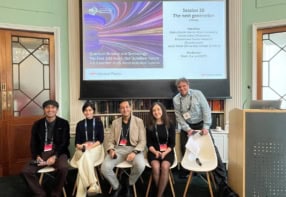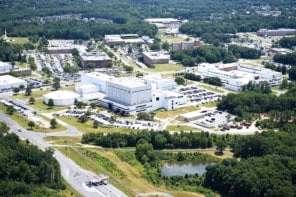James McKenzie reflects on how the World Wide Web has transformed every aspect of our lives since its creation at CERN 30 years ago

As you probably don’t need reminding, the World Wide Web was devised in 1989 by Tim Berners-Lee – a British computer scientist working at the CERN particle-physics lab near Geneva. What’s less well known is that the first Web server was a NeXTcube work station, built by the firm that Steve Jobs founded after he left Apple in 1985.
When I recently saw the machine on a visit to CERN’s amazing Microcosm museum, I had to smile when I saw the handwritten sticker on it, which said: “This machine is a server – DO NOT POWER DOWN!!” It’s hard to believe that this innocuous device is where the Web began.
Written on Berners-Lee’s initial proposal for information management, dated March 1989, were his supervisor’s handwritten words: “Vague but exciting”. But why did Berners-Lee, who originally studied physics at the University of Oxford, come up with his idea for the Web? After all, initial reaction wasn’t overly enthusiastic. It’s obvious, though, when you remember why CERN exists.
Connect and compute
Ever since it was founded in 1953, the lab has needed computers to collect and analyse the vast amounts of data from detectors on its various experiments. And because CERN is an international collaboration, scientists from universities across Europe and beyond travelled to CERN to carry out experiments, which meant they needed a way to share that data too.
Although CERN was, by the early 1970s, an early adopter of computing, there were very few standards in computer systems.
But the story was far from straightforward. Although CERN was, by the early 1970s, an early adopter of computing, there were very few standards in computer systems. Many who worked there say CERN was chaotic, with a huge variety of protocols in use; indeed, open warfare existed between many manufacturers’ proprietary systems and CERN’s own homemade networks.
By the 1980s, however, things were more organized, with CERN setting up a data communications group to bring order to the chaos. Berners-Lee worked briefly at CERN in 1980, where he built software called ENQUIRE, which served two functions. It was partly a personal database of people and software models, but also a way for him to explore the use of “hypertext”, with each new page of information in ENQUIRE having to be linked to an existing page.
After a spell back in the UK, Berners-Lee rejoined CERN in 1984. At this point he realized that physicists who needed to share data lacked common machines and universal software interfaces. Soon, though, Internet protocol (IP) interfaces were installed on most machines, allowing devices from different manufacturers to communicate and interoperate via a common addressing and packet structure. Within a few years, CERN was home to Europe’s largest Internet site.
And so it was that by 1989 CERN’s Internet facility was ready to become the medium within which Berners-Lee could create the Web. An entire culture had developed at CERN around “distributed computing” and Berners-Lee’s 1989 proposal discussed the idea of “a large hypertext database with typed links”.
By 1989 CERN’s Internet facility was ready to become the medium within which Berners-Lee could create the Web.
The proposal attracted little interest, but Berners-Lee was encouraged when his boss, Mike Sendall, began implementing the system on that newly acquired NeXTcube workstation. Berners-Lee apparently considered several names, including Information Mesh, The Information Mine, or the Mine of Information, before settling on World Wide Web – a good choice, I think.
Then, on 30 April 1993 CERN put the World Wide Web software into the public domain. Later, CERN made a release available with an open licence, which was a surer way to maximize its dissemination. These actions allowed the Web to flourish – and the rest is history.
What could it do for me?
In the early 1990s most people didn’t know they needed the Web or what it could do. After all, it was developed by particle physicists who had big problems to solve – and few of us needed to look for the W boson. So to really make the Web useful, accessible and affordable for everyone else, some more enabling technology was needed, which duly appeared in the form of cheaper personal computers, search engines, broadband, WiFi and – later – smart phones.
The impact of the Web has been immense. It has enabled all sorts of new business models, but you only have to look at small companies to see how much things have changed since I left university in 1989 with a degree in physics and computing. Back then, small firms would open a shop, advertise in the local paper or radio, join a local networking organization, and hope that local customers needed what they had to offer. Location or well-targeted advertising was key to success.
While the Web may give small businesses global access, they are now small fish in a very big pond.
With the Web, however, businesses can reach customers across the globe and no longer depend on a local customer base to survive. Online shopping has transformed retail and decimated the high street, even though only 10% of sales are online by volume. Sites like Amazon and eBay look unstoppable. But while the Web may give small businesses global access, they are now small fish in a very big pond. Their website may be the storefront, but getting found and maintaining a positive reputation is an ongoing battle.

Electronic publishing and visions of hypertext
A decade ago, ensuring your website had the right keywords and a few banner ads was enough to deliver traffic to your store. Now, successful businesses have to play the new games of creating and placing shareable multimedia content, exploiting product placement with online influencers and bloggers, and investing time in managing very public – and occasionally highly critical – feedback. Customers spend more time online, but if they can’t find what they want within three clicks, they leave your store.
As for the future of the Web, one thing is sure: it’s not going away. Just look at Google: it started in 1998 and is now one of the biggest companies in the world. The Web will keep growing and expanding but just remember – without physics it would be nothing.



